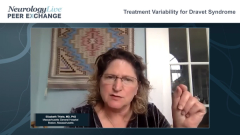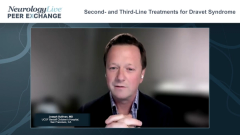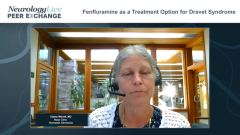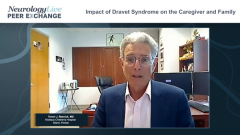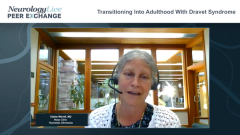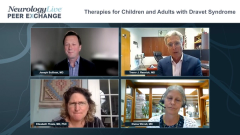
Second- and Third-Line Treatments for Dravet Syndrome
Experts in the field discuss second- and third-line treatment options for Dravet syndrome such as stiripentol and vagal nerve stimulation and the effects they’ve seen on patients.
Episodes in this series

Joseph Sullivan, MD: I keep reiterating this theme that it’s extremely valuable to have a specific diagnosis. It is mixed seizures. We know that our different antiseizure medications have maybe differential efficacy against different seizure types. Trevor, how much experience have you had with stiripentol? Then maybe look into that third tier before we get into some of the new medications that we generally don’t think of as being syndrome-specific, like vagal nerve stimulation [VNS] and zonisamide. Pick one and let me know your thoughts on that.
Trevor J. Resnick, MD: That’s the catch-as-catch-can. A very good point you just made is that, especially after the first year of life, the different seizure types dictate your choices. Even though you have this list of guidelines, which we follow, a lot of the choices that come afterward in the second and third line are choices dictated by the predominant seizure type that affects that specific child. Our experience with stiripentol has been pretty much as adjunctive therapy, and it certainly has not been a knock-your-socks-off response. Some children have responded quite well with the adjunctive treatment with stiripentol. The treatment we have found to be gratifying has been the ketogenic diet. Even though we don’t start with the ketogenic diet, we often find that we fall back onto it pretty quickly. I almost feel that if you look at the list of clobazam and valproate as first-line treatments, the ketogenic diet is often the secondary treatment if one of those fail. I don’t know if everybody else has had a similar experience.
Joseph Sullivan, MD: I probably have about 7 or 8 teenagers who have vagal nerve stimulators. I have personally never recommended a vagal nerve stimulator to be placed for any of my patients with Dravet syndrome. These are patients who I either inherited or came to me. When they’ve been through 7 or 8 different medications, just like we do with all of our other refractory epilepsies, and they didn’t have a Dravet syndrome diagnosis, they’re like, “Let’s try VNS.” It’s effective. It can have a 50% reduction in seizures. Then the families feel like it worked. Getting back to the different stages of the disease, they would say, “Well, they didn’t end up going into status [epilepticus] anymore.” I have no data to back this, but I wonder if that was more the natural history. They put the VNS in maybe when they were 5 years old, and then over the next few years, their episodes of status decreased. It’s important, though, because when it comes time for the battery to be replaced, it’s always a difficult decision to give families counsel. Do you replace it or do you not? I’m curious to hear other people’s opinions about VNS.
Trevor J. Resnick, MD: I agree exactly. I never know whether it’s the natural history of the disease or the specific treatment, especially when it’s done at a specific age. I don’t know how valuable that discussion is with the parents, because they only see what’s happened to their child, and it’s a very difficult discussion to have.
Elizabeth Thiele, MD, PhD: We’ve had the VNS longer than we’ve had SCN1A gene testing. I have several patients with VNS who ended up having Dravet syndrome. For some of them, it has been effective. I agree that with any kid who gets VNS, how do you know if it’s really the VNS or the natural history of their epilepsy? When the generator is reaching end of service, I discuss with the family to see what happens with seizures. A couple of my kids with Dravet syndrome have had an increase in seizures, and sure enough, the battery is low. They replace the battery, and their seizure control improves again. It can be effective, but it’s like what Trevor said about stiripentol. It’s definitely not a silver bullet, but I don’t think it’s usually effective in this patient population.
Elaine Wirrell, MD: A lot of kids who are coming to battery end of life would now have the opportunity to be on some newer, more effective agents. Before you jump in and replace that battery, it’s very reasonable to see if the seizures worsen.
Joseph Sullivan, MD: Absolutely. I have a closing comment about the medications we’ve talked about so far. This is anecdotal, when we sit around the table and talk, especially with our European colleagues who have had stiripentol for 2 decades. The stage-specific nature of the disease and the different seizure types that occur at that first stage in episodes of status [epilepticus] are very common. I certainly have experienced that with stiripentol. Some of our colleagues said that they don’t go to the ICU [intensive care unit] anymore. It may not reduce the overall frequency in such a significant manner where it’d be measurable in a clinical trial, but keeping them out of the emergency department and keeping them from calling 911 and getting into the PICU [pediatric intensive care unit] has certainly been my experience.
Thank you for watching this NeurologyLive® Peer Exchange. If you enjoyed the content, please subscribe to our e-newsletters to receive upcoming Peer Exchanges and other great content right in your inbox. Thank you.
Transcript Edited for Clarity
Newsletter
Keep your finger on the pulse of neurology—subscribe to NeurologyLive for expert interviews, new data, and breakthrough treatment updates.


